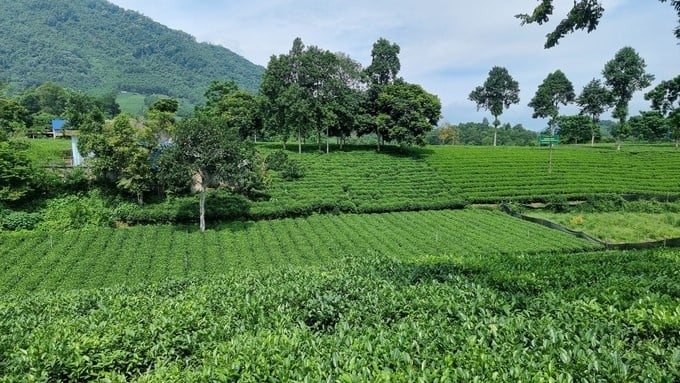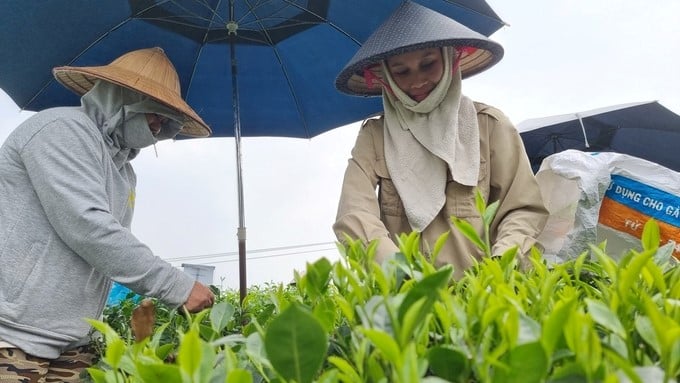November 22, 2025 | 04:48 GMT +7
November 22, 2025 | 04:48 GMT +7
Hotline: 0913.378.918
November 22, 2025 | 04:48 GMT +7
Hotline: 0913.378.918

Tan Cuong tea area. Photo: Toan Nguyen.
Currently, the Tan Cuong specialty tea area includes six communes on the outskirts of the city, covering about 1,500 ha, which were granted a Certificate of Tan Cuong Tea Geographical Indication Protection by the Intellectual Property Office of Viet Nam under the Ministry of Science and Technology.
According to Mr. Pham Tien Sy, Secretary of the Party Committee and Chairman of the People's Committee of Tan Cuong Commune, tea is now a tree not only to escape from poverty but also to get rich, with an annual output of approximately over 22,000 tons. From small and scattered farmer households in the past, people in Tan Cuong have expanded their scale and linked into cooperative groups, cooperatives, businesses, and traditional tea craft villages since the appearance of Nui Coc Lake and the electricity grid. Many tea growers have become rich and become big names in the tea land, such as Thang Huong, Hao Dat, An Duong, and Huong Van Tra cooperatives, etc.
"Especially in the post-2011 period, the Thai Tea Festival was first held, aiming to both promote the image and brand of Thai tea and improve the economic value for tea growers," said Mr. Pham Tien Sy. A space for Tan Cuong tea culture has also been built majestically in the center of the commune, contributing to an increase in value and more international tourists knowing about Thai tea.
In 2017, Dinh Vuong Pham tea from the Tan Cuong tea line participated in an international competition and won the special prize of North American International Specialty Tea, honored by the Tea and Herbal Associations of America and Canada. In the same year, Tan Cuong tea was selected as a gift for delegates at the APEC Economic Leaders' Meeting held in Da Nang.
Just about two months ago, in one day, Tan Cuong commune announced three important decisions. Those are the decision to include in the list of national intangible cultural heritage "Knowledge of Tan Cuong Tea Cultivation and Processing", the decision that Tan Cuong commune meets the new-style rural area standards in 2022, and the recognition of the Tan Cuong community-based tourism destination.
Mr. Pham Tien Sy does not hide his pride and happiness when mentioning the decisions. According to him, the decisions mean that in today's tea land, tea trees are not only a livelihood but also a culture, crystallized from the land and from a long-standing traditional profession, so they need to be protected, preserved, and transmitted. As for the future, the project on conservation and development of the Tan Cuong specialty tea area in the 2021–2025 period is also being implemented. The objective of the project is to protect the existing tea area and expand the area by 2025 to strive to reach 1,700 ha, where the yield of fresh bud tea reaches 155 quintals/ha, the output reaches 25,000 tons, and the value of income per hectare of tea-growing land reaches over VND 1 billion.

Tan Cuong farmers harvest tea. Photo: Hoang Anh.
"Inefficient rice farming land and production forest land will be converted to tea farming in the direction of increasing value and forming concentrated tea production areas. Then, not only Tan Cuong commune but other communes in the tea area will have 100% of the tea area in the concentrated raw material production area applied to the technical process of safe and quality tea production; 100% of tea products are produced by affiliated enterprises and cooperatives according to safety standards with the growing area code, packing establishment code, stamp of traceability, etc.," said the Secretary and Chairman of Tan Cuong commune.
Teacher Dai asked me, "Do you know why Tan Cuong was honored as the "first famous tea?" Asking, and then he self-answered that it is thanks to the characteristics of the soil, water source, climate of the Cong River, Guoc Mountain, and the talented hands of the people. From the beginning of the last century, when Mr.Doi Nam just brought tea varieties from Phu Tho to plant in this land, it showed the difference. The same variety grown in Tan Cuong gives a tea type with enough clarity, color, flavor, taste, and spirit. The first is due to that characteristic.
The old man poured a cup of tea. It is made from the ancient midland tea variety. In Tan Cuong, from the young to the old, every family has such a gentle way of saying "first cup of tea". To make it easier to compare, the same variety was originally planted in Binh Son land, a river from Tan Cuong, but gave nothing special. Only when brought to plant in this place can there be a kind of green tea with an amber color, drinking in first an acrid and then sweet, greasy taste, but with a green rice flavor. And the thing that gives it the title "first famous tea" is the spirit. When drinking Tan Cuong tea, in addition to the sweet, acrid taste, the green rice flavor always makes the spirits of tea drinkers feel lifted and refreshed.

Clement weather, favorable terrain, and concord among the people create the reputation of Tan Cuong tea. Photo: Toan Nguyen.
It is so special that a Tan Cuong child was born with a permeation of tea taste in his mother's womb, and even when he is an adult, he can't forget the famous drink in his hometown.
There was a delegation of Tan Cuong commune officials who were able to travel to the southern provinces for the first time, but no matter how eager they were, they forgot to bring home tea with them. As soon as the plane landed, it was time to have a tea attack, so they bought a few industrial-style tea bags to try, not to the point of vomiting, but every man was dumbfounded as if he had lost his soul for a whole week. As for the people from other lands, if they taste Tan Cuong tea even once, they will be confused by it. The sweet, acrid, and soft-lip taste of our tea is as if it is always absorbed into the blood, until it is bland and tasteless when drinking tea elsewhere.
The quintessence of heaven and earth converge. There have been many research works by both domestic and foreign experts on Tan Cuong tea, and finally, scientists concluded that the reason why this place is considered the "first famous tea" is first of all thanks to the characteristics of land, climate, and a special geographical location. The Tan Cuong land is mainly bowl-shaped hills, inheriting the alluvial source of thousands of generations of the Cong River and red-yellow feralit soil, so growing anything is all lush. Tan Cuong’s climate is divided into two seasons. The hot season starts from April to October; the rest is the cold season. The mild weather combined with the clear blue water from the Tam Dao range makes it seem as if God created this land to grow tea. The land is not too high or too low and is shielded by the Tam Dao range, scattering sunlight and having both clement weather and favorable terrain. Those God-given things, when combined with labor efforts crystallized and drawn from generation to generation in the traditional tea profession in Tan Cuong, make famous and delicious teas.
"That is concord among the people. It's also strange that all of the tea varieties are from the lowlands, but Tan Cuong tea is famous for its tea industry. Maybe it is because the Creator loves a class of expatriates who have been so industrious and not afraid of hardship that he gave them the tea-making profession to make their livelihood,” said Teacher Dai.
Translated by Huyen Vu Thu

(VAN) The information was shared at the seminar 'Urban Agriculture - Solutions for Developing Green Spaces,' organized by the Kinh te & Do thi Newspaper and the Biotechnology Center of Ho Chi Minh City.
/2025/11/19/4141-2-132831_216.jpg)
(VAN) One of Japfa's outstanding solutions is implementing digital transformation and artificial intelligence (AI) to optimize operations, enhance productivity, and advance sustainable development.
/2025/11/19/4847-1-093540_448.jpg)
(VAN) The Gia Lai Provincial People’s Committee had a working session with the delegation of the U.S. Department of Agriculture, the State of Idaho, and representatives of the State's leading enterprises.

(VAN) Ca Mau has a sufficient foundation to become a strong regional aquaculture center, where production integrates the economy, the environment, and the lives of the people.

(VAN) SEIKI Group envisions itself as a pioneer in the ‘dual transformation’ of digital technology and green industry, standing alongside the Government and Vietnamese businesses in their pursuit of sustainable development.

(VAN) The VNGEONET network affirms Viet Nam's progress in mastering digital space, providing a precise positioning data platform to serve socioeconomic development.
/2025/11/14/3247-1-184556_35.jpg)
(VAN) Thai Nguyen is methodically implementing digital transformation in the livestock sector, laying the foundation for a modern, transparent, and sustainable agriculture.